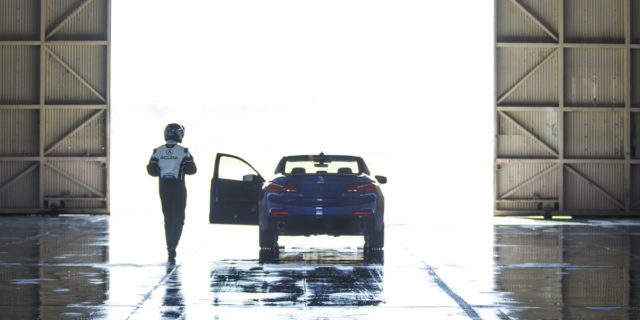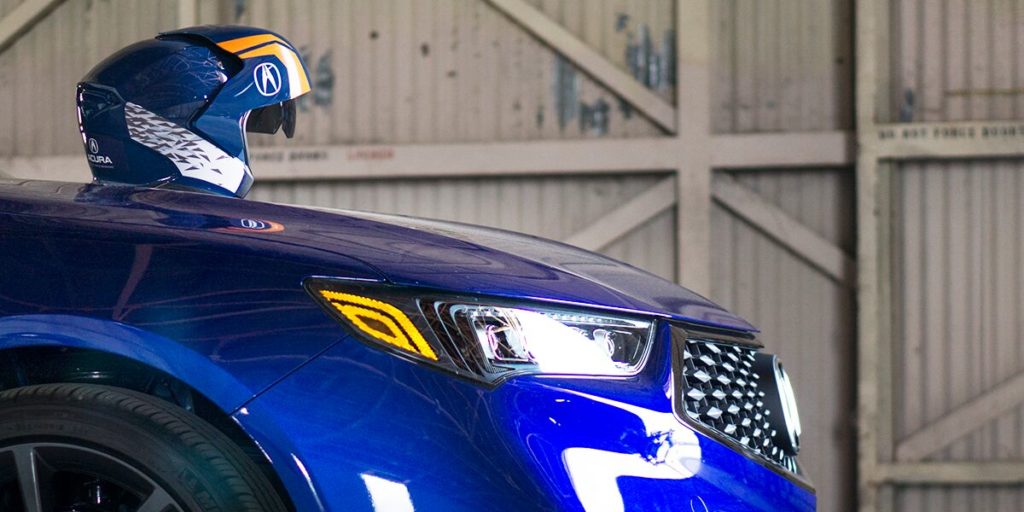Acura created the first-ever, live, augmented reality race, which the car manufacturer livestreamed on Facebook on Monday. The “What A Race” marketing activation was designed to showcase the performance of the 2018 TLX A-Spec sedan.
Jessica Fini, social media manager for American Honda Motor Company, told AListDaily that while 360-degree video and virtual reality are great immersive technologies, they still simulate everything the spectator sees and hears.
“Acura is a premium car brand, and that means we have a number of very real, physical, tangible products we want our audience to experience,” Fini said. “No matter how good a VR simulation is, it’s never going to be as good as actually sitting behind the wheel.”
Fini said AR makes it possible for the brand to combine the premium experience of sitting in and driving an Acura TLX via the immersive worlds and experiences created with real-time gaming engines. The AR technology makes it so the driver can go from Antarctica to the Amazon jungle to erupting volcanoes in the Pacific Rim all in one sitting. At the same time, the smell of a new car, the feeling of being pushed back in the seat when accelerating and the roar of an engine are not simulated sensations—they’re real because they’re created by actually driving the TLX.
Acura enlisted Chuck actor Zachary Levi and technology influencers Sam Gorski, Dom Esposito, Maude Garrett and hosts NSX GT3 racecar driver Ryan Eversley and online personality Bradley Hasemeyer to partake in the livestreamed event.
The car brand leveraged targeted paid media and organic tactics to connect with audiences interested in its brand, as well as those interested in subjects like emerging technology and video gaming. Acura also partnered with a series of influencers who further amplified the experience with their audiences, specifically within Twitter and YouTube. On Facebook Live, Acura allowed viewers to influence the racetrack, connecting the crowd and driver. Through Facebook reactions and comments, viewers opened shortcuts and offered support to drivers while they’re on the tracks. Prompts encouraged fans to use reaction emoji throughout the race, revealing shortcuts and clearing obstacles to influence the course’s landscape.
“Our four competing drivers were not professional drivers, and they didn’t know what they’re getting into,” Fini said. “We had full confidence that all of them would have a great time as they go through the race of a lifetime.”
The idea for “What A Race” came from Acura’s newest feature—super handling all-wheel drive (SH-AWD)—which Fini said enhances the driving experience through a series of advanced, real-time calculations of individual wheel velocity, steering angle, engine torque, transmission gear and lateral acceleration to apply the optimal torque distribution at any time during the drive.

“To tell that story, we wanted to combine the precise nature of SH-AWD with the unpredictable nature of an ever-changing racecourse, one where regular drivers get to drive the car in a race consisting of three totally different and uniquely challenging environments,” Fini said.
Acura looked no further than the video game culture to create this real-life AR race.
“Video games had a tremendous influence on this project,” Fini said. “Video game technology is also what enabled Acura to bring this idea to life in the first place. Modern, real-time 3D game engines and the hardware that runs them have become incredibly powerful in recent years, and this gives us great potential for innovative, technology-powered creative work.”
Acura teamed up with AR production firm Current Studios to concept and execute the “What A Race” experience, where drivers wore custom-built race helmets with AR technology embedded in the extra-wide visor, allowing for a full-color high definition, 80-degree viewing experience.
The helmets are connected to a computer in the rear seats that provides the high performance rendering capacity needed to keep the experience running smoothly and visually sharp at high speeds—all powered by the Acura TLX.
“The cutting-edge piece of technology allowed Acura to integrate the real and virtual worlds in a completely new way,” Fini said. “Creatively, that meant the sky was the limit in deciding which environments we wanted to bring the TLX into and how we wanted to test the car in these different environments. We were able to play around with an infinite number of variables when designing the landscape, road layout and driving challenges for each of these worlds.
The Current Studios team patched into the TLX’s ABS system to accurately track the vehicle’s wheel speed and direction. To further mitigate any potential technical snafus during the race, the team custom fabricated a device attached to the undercarriage of the vehicle, allowing the location of the car in the AR world to be automatically reset remotely and quickly, as needed.
“A main pillar of this project was authenticity,” Fini said. “Technology enabled us in bringing the race to the world live, in a way that allowed our audience to interact with the virtual world, without smoke and mirrors. With Facebook Live, overlayed the AR world on top of the racetrack, and suddenly the live audience saw everything the driver was seeing. . . . This made it a truly unique and first-time experience for our audience.”

